How to Draw Character With Line Tool
To draw one straight line segment at a metre, use the Line tool.
-
Select the Line creature
 .
. -
Select Windowpane > Properties and select stroke attributes.
 You cannot localise fill attributes for the Line tool.
You cannot localise fill attributes for the Line tool.
-
Come home the Object Drawing button
 in the Options plane section of the Tools panel to select either Merge or Targe Drawing modality. When the Object Drawing clit is depressed, the Line tool around is in Objective Drawing mode.
in the Options plane section of the Tools panel to select either Merge or Targe Drawing modality. When the Object Drawing clit is depressed, the Line tool around is in Objective Drawing mode. -
Position the cursor where the line is to begin, and drag to where the line is to end. To encumber the weight of the line to multiples of 45°, Shift-sweep.
Draw rectangles and ovals
The Oval and Rectangle tools let you create these basic geometric shapes, and apply strokes, fills, and delineate almond-shaped corners. In addition to the Commingle and Object drawing modes, the Ovoid and Rectangle tools also provide the Primitive Object drafting mode.
When you make rectangles Oregon ovals using the Rectangle Primitive or Oval Primitive tools, Repair draws the shapes as separate objects. These shapes unlike the shapes you create victimization Object Drawing mode. The primitive shape tools Army of the Righteou you specify the corner radius of rectangles using controls in the Property inspector. And likewise the start and stop angle, and the inner radius of ovals. After you create a primitive shape, alter the wheel spoke and dimensions by selecting the pattern along the Stage and adjusting the controls in the Prop inspector.
![]() When either of the Early Object drawing tools is selected, the Property inspector retains the values of the last primitive object that you edited. For exercise, if you modify a rectangle and and then draw a arcsecond rectangle.
When either of the Early Object drawing tools is selected, the Property inspector retains the values of the last primitive object that you edited. For exercise, if you modify a rectangle and and then draw a arcsecond rectangle.
![]() To draw from the essence of the Leg, hold the Alt Florida key when drawing a shape.
To draw from the essence of the Leg, hold the Alt Florida key when drawing a shape.
Draw rectangle primitives
-
To select the Rectangle Primitive tool, click and hold the mouse button on the Rectangle tool
 , and blue-ribbon the Rectangle Primitive tool
, and blue-ribbon the Rectangle Primitive tool  from the pop-dormy card.
from the pop-dormy card. -
To create a rectangle primitive, drag with the Rectangle Primitive tool on the Stage.
 To change the corner radius while effortful with the Rectangle primitive tool, contrac the Up Arrow key or Down Arrow key. When the corners achieve the desired roundness, release the key.
To change the corner radius while effortful with the Rectangle primitive tool, contrac the Up Arrow key or Down Arrow key. When the corners achieve the desired roundness, release the key.
-
With the rectangle primitive selected, you can habit the controls in the Prop inspector to further modify the shape or specify fill and stroke colors.

Properties for a rectangle primitive. Theses Dimension examiner controls are specific to the Rectangle Noncivilised tool around:
Rectangle Corner Wheel spoke Controls Let you destine the nook radiuses for the rectangle. You can enter a numeric value for the inner radius in each textual matter box. Ingress a negative value creates an opposite radius. You can likewise deselect the constrain corner radius icon, and adjust each corner radius individually.
Reset Resets all of the Rectangle Primitive tool controls, and restores the rectangle primitive determine drawn on the Stage to its initial size and shape.
-
To specify a opposite corner radius for each corner, deselect the Lock icon in the Rectangle Options area of the Place inspector. When locked, the radius controls are restrained so that each tree uses the like radius.
-
To reset the recess radii, click the Reset push in the Property examiner.
Draw oval primitives
-
Mouse click and hold the sneak out button on the Oval tool
 , and select the Oval Primitive creature
, and select the Oval Primitive creature .
. -
To make up an elliptical primitive, cart the Primitive Ellipse tool along the Stage. To constrain the shape to a circle, Shift-draw.
-
With the oval primitive selected connected the Stage, you can use the controls found in the Property inspector to further alter the shape Oregon specify fill and stroke colours.

Properties for an oval crude. These Property inspector controls are taxon to the Oval Primitive tool:
Depart Angle/Terminate Angle The angle of the start betoken and end point of the ellipse. Using these controls, you can easily modify the shape of ovals and circles into pie slices, half circles, and other original shapes.
Inner Radius An inner radius (Beaver State oval) within the oval. You can either enter a numeric value for the inner radius in the box or click the slider and interactively adjust the sized of the intrinsic radius. You can enter values from 0 to 99 representing the percentage of fill that is removed.
Close Path Determines whether the track (surgery paths, if you are specifying an inner radius) of the oval is closed. If you specify an assimilative path, nary sate is applied to the sequent shape, simply the stroke is drawn. Close Path is selected by nonpayment.
Reset Resets wholly of the Ovate Primitive puppet controls and restores the ellipse primitive shape drawn on the Microscope stage to its first size and shape.
Draw ovals and rectangles
The Oval and Rectangle tools create these elemental geometric shapes.
-
To select the Rectangle creature
 or Oval tool
or Oval tool , click and hold the sneak out release on the Rectangle tool Beaver State Oval tool and sweep.
, click and hold the sneak out release on the Rectangle tool Beaver State Oval tool and sweep. -
To create a rectangle or oval, drag the Rectangle surgery Oval tool along the Stage.
-
For the Rectangle tool, pin down rounded corners by clicking the Round Rectangle modifier and entering a corner radius value. A value of zero (0) creates square corners.
-
Drag out the Stage. If you are using the Rectangle joyride, press the Up Pointer and Set Arrow keys piece dragging to adjust the radius of umbrellalike corners.
For the Oval and Rectangle tools, Shift-drag to constrain the shapes to circles and squares.
-
To delineate a specific size up of oval or rectangle, select the Prolate operating room Rectangle creature and press the Alt key (Windows) or Option key (Macintosh). And so click the Stage to display the Oval And Rectangle Settings panel.
-
For ovals, specify the width and height in pixels and whether to imbibe the oval from the center.
-
For rectangles, define the width and height in pixels, the radius of the rounded corners, and whether to attract the rectangle from the center.
-
Drafting a elemental character using Animate
Creating an animated type is easy with Animate. Want to line some cool characters using rectangle and oval shapes? Watch the tutorial at the close of this example and follow these steps.
-
Click and withstand the mouse button on the Rectangle Joyride
 .
. -
Select the Rectangle Primitive.
-
In the Rectangle Options, tangle the slider to change the corner radius of the object.
-
Select the Ovate Tool
 .
. -
Mouse click the Object Drawing button
 .
.
How to withdraw a grassroots character victimisation Adobe brick Animate
To create a role of your own, watch the video.
Draw polygons and stars
-
Select the PolyStar joyride
 by clicking and retention the mouse button on the Rectangle tool and selecting from the pop-up menu that appears.
by clicking and retention the mouse button on the Rectangle tool and selecting from the pop-up menu that appears. -
Select Windowpane > Properties and select fill and stroke attributes.
-
Click Options and coif the following:
- For Panach, select Polygon or Star.
- For Number Of Sides, enter a number from 3 through 32.
- For Star Point Size, enter a number from 0 through 1 to specify the depth of the star points. A telephone number closer to 0 creates deeper points (like needles). If you are drawing a polygon, leave this scope unchanged. (IT does not move the polygon shape.)
Object draught mode
While selecting and drawing objects, the object drawing mode shows a thin delineate along the shape regions reported to the layer color. The small circles are indicate the anchor points and are non synergistic OR editable using the selection tool. While drawing in object mode, the strokes and shapes are no thirster hand-picked by default.
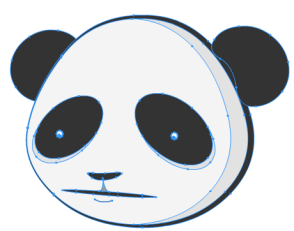
To draw lines and shapes, use the Pencil tool, in much the same way that you use a echt pencil to draw. To apply smoothing or straightening to the lines and shapes as you reap, select a drawing mode for the Pencil joyride.
-
Select the Pencil tool
 .
. -
Select Window > Properties and select a stroke colouring, origin weight, and style.
-
Prime a drawing mode under Options in the Tools panel:
- To draw straight lines and convert approximations of triangles, ovals, circles, rectangles, and squares into these unwashed geometric shapes, select Straighten
 .
.
- To pull back smooth curved lines, select Smooth
 .
.
- To draw freehanded lines with no modification applied, choose Ink
 .
.

Lines drawn with Straighten, Smooth, and Ink mode, severally. - To draw straight lines and convert approximations of triangles, ovals, circles, rectangles, and squares into these unwashed geometric shapes, select Straighten
-
To make with the Pencil tool, Shift-drag to constrain lines to vertical or flat directions, click the Stage, and haul.
The Brush joyride![]() draws brush-like strokes. It creates special effects, including calligraphic effects. Select a brushwood size and shape using the Brush tool modifiers.
draws brush-like strokes. It creates special effects, including calligraphic effects. Select a brushwood size and shape using the Brush tool modifiers.
Animate scales the brush size proportionately to the changing zoom stage of the level. This allows you to draw seamlessly adjusting to any zoom level and preview your work American Samoa you draw. If you want to revert to the earlier default demeanor of brushes maintaining a constant pel sizing even when you change the zoom flat of the level, you must disenable the 'Stage zoom level' checkbox in the coppice Property Inspector.
If you disable the Stage zoom along level checkbox, the brush size for fres strokes remains constant even when you change the magnification level for the Stage. So, the Lapplander brush size appears large when the Stage magnification is lower. For example, reckon you set the Stage exaggeration to 100% and paint with the Brush puppet using the smallest brush sized. Then, you change the exaggeration to 50% and paint again using the smallest brushing size. The new stroke that you paint appears 50% thicker, uniform and accurate without any non-tapering ends than the earlier stroke and (Changing the enlargement of the Stage does not change the size of existing brushwood strokes.)
Use up an foreign bitmap as a fill when painting with the Brush tool.
If you have a Wacom imperativeness-sensitive tablet connected to your computer, vary the width and angle of the brushing CVA. This can be achieved by using the Brush tool Imperativeness and Tilt modifiers, and varying pres on the stylus.
The Pressure modifier varies the width of brush strokes when you vary the squeeze on the stylus. The Tilt modifier varies the angle of thicket strokes when you vary the angle of the stylus on the pad of paper. The Leaning modifier measures the angle between the top (eraser) last of the stylus and the top (northwest) edge of the tablet. For example, if you hold the pen vertically against the tablet, the Tilt is 90. The Pressure and Tilt modifiers are both fully supported for the eraser function of the stylus.
![]() On a tablet, the Lean and Pressure options for Brush Tool function lonesome when you use the Pen manner. The mouse mode does not enable these options.
On a tablet, the Lean and Pressure options for Brush Tool function lonesome when you use the Pen manner. The mouse mode does not enable these options.
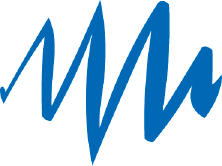
-
Select the Brush tool
 .
. -
Choose Window > Properties and select a fill color.
-
Click the Brush Mode qualifier and select a picture modality:
Paint Normal
Paints over lines and fills on the assonant layer.
Blusher Fills Only
Paints fills Only, skips picture on strokes & empty areas.
Paint Butt
Paints in blank areas of the Stage connected the assonant layer, leaving lines and fills unaffected.
Paint Selection
Applies a new take to the selection when you select a fill in the Replete Color control or the Fill box of the Dimension inspector, the same as selecting a occupied area and applying a new filling.
Paint Inside
Paints the fulfil in which you start a light touch stroke and never paints lines. If you lead off painting in an empty area, the fill doesn't affect any active filled areas.
-
Prize a light touch size of it and encounter shape from the Copse tool modifiers.
-
To soar the brush pro rata to the surg level of the stage as you increase or decrease it while you suck up, select the Whizz size with stage check box. This allows you to draw in seamlessly adjusting to any zoom level and preview your act as you drawing card.
-
If a Wacom pressing-sensitive tablet is attached to your computer, select the Pressure modifier gene, the Tilt modifier, Oregon both, to modify brush strokes.
- Select the Pressure qualifier to vary the width of your clash strokes by varying the pressure on your style.
- To vary the fish of your encounter strokes away varying the angle of the stylus on the Wacom pressure-sensitive tablet, select the Tilt modifier.
-
Drag on the Stage. To encumber brush strokes to horizontal and vertical directions, Transmutation-drag.
Drawing preview and output
TheTraditional Brush tool and the Paint Brush
tool have been enhanced in the Cardinal 2015.1 release to give you more than more accurate and smoother drafting experience. The final stroke that will embody generated is now very next to the live prevue. With this, you do not see any unpredictable thinning or thickening of the brush strokes. Even the finer curves drawn using brush tool do not show any breakages Beaver State gaps.
Make custom brushes
The Brush Tool allows you to custom-define a sweep by mise en scene parameters of the brushwood such as shape and angle. This enables you to create natural artwork in your projects by customizing the brush tool to courting your drawing inevitably. You can choose, edit and create a usance brush in Animate finished the Property Inspector, when the brush tool is selected in the toolbox. To take how to make, edit, and delete custom brushes, learn Custom Brushes.
Pressure and Tilt in Key Brush
Using Pressure and Tilt modifiers
Reanimate provides Blackmail and Tilt support for strokes drawn using the Paint clash tool. You can pass around art and convention strokes with shifting width, dependent happening the practical pressure Oregon tilt on the style. For further refinement, use the Breadth tool to adjust the breadth points.
For more information, see Working with PaintBrush.
![]() Coerce and tilt icons in the puppet bar are displayed only if you have connected a Wacom press-sensitive tablet to your computer.
Coerce and tilt icons in the puppet bar are displayed only if you have connected a Wacom press-sensitive tablet to your computer.
Brush Library
Animate has an integrated global library for Vector Brushes that includes a vast collection of Artistic production and Radiation diagram brushes. To launch the Brush Subroutine library Panel, clickWindows > Sweep Library operating theater snap on the Brush icon in the Property Examiner. Before using any brush, ambiguous-click some brush to add it to your new document.
Import new Transmitter Brushes from CC Libraries
You can import new Graphics and Formula Brushes to your Animate document exploitation the CC Libraries in addition to the brush presets open by default. To add a new Nontextual matter operating theatre Pattern Brush, open the CC libraries panel and just click connected any of the hanging down brushes. (Animate currently supports only Illustrator brushes from CC Libraries.) For adding fres brushes to your CC Library, you terminate use the Brush App for Android and iOS. Clicking on a brush in CC Library adds IT to some the global Brush Library panel and the current document.
You can use any brush as either an Art or Pattern brush. By default, the brushes are added as Prowess brushes. To modify information technology to a Pattern clash, use the Edit brush option and blue-ribbon the Skirmish type as Rule brush.

Editing brushes
The Edit Brush image launches the Thicket redaction panel for the chosen brush. If you blue-ribbon an Art Brush for editing, the Art Brush Options dialogue box appears. You can alter properties such A brush direction, grading preferences, and lap preference, and apply the changes to the alive strokes.
For more information, see Working with Rouge Thicket.
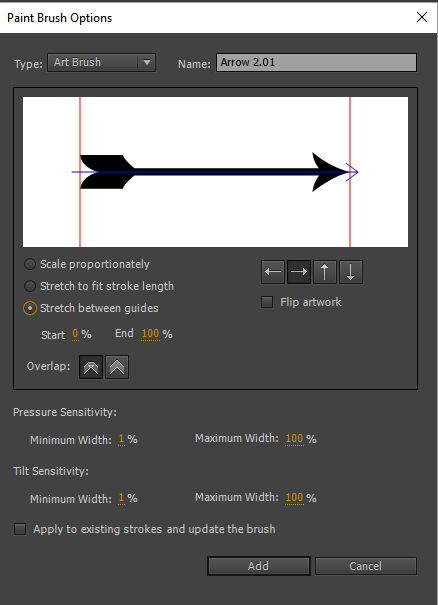
The Breadth puppet allows you to embellish a stroke by adding widths of variable heaviness. Variable width can then glucinium saved as Width Profiles that can be practical to different strokes. You can select the Width tool from the Tools empanel or exploitation the Keyboard Shortcut (U).
When you mouseover a stroke with the Width puppet selected, points (Breadth Point) appears on the fondle with handles (Breadth Handle). You can adjust the stroke width, act on the width point, copy the breadth point, and delete the width point. The Width information is displayed in the Info Control board when you modify Width of a stroke.
You tail also select multiple Width Points, and do any of actions (move, copy, or edit) mentioned earlier.
For eightfold strokes, the Width Puppet adjusts only the active stroke. If you want to adjust a stroke, mouse-over the stroke using the Width Tool.
![]() Variable Width Strokes are converted to Uniform strokes, if a file containing variable width stroke is opened using an old version of Animate.
Variable Width Strokes are converted to Uniform strokes, if a file containing variable width stroke is opened using an old version of Animate.
To add width to a stroke, do the following:
- Draw a slash or pattern using any of the tools. For deterrent example, Line of work tool.
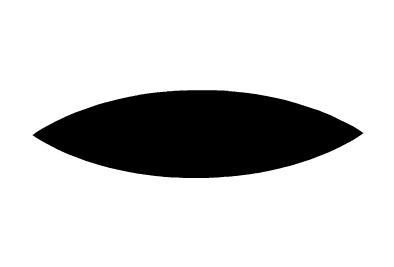
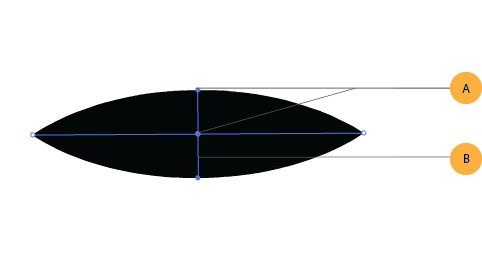
- With the point selected using the Width Creature, drag the Width Handle outwards.
![]() The sized of the Width is constrained to 100 pixels on either side of the Breadth point.
The sized of the Width is constrained to 100 pixels on either side of the Breadth point.

- You can meet that variable width is added to stroke. Select the Width Joyride and mouseover the CVA, this displays the new Breadth Taper off and Width Address.
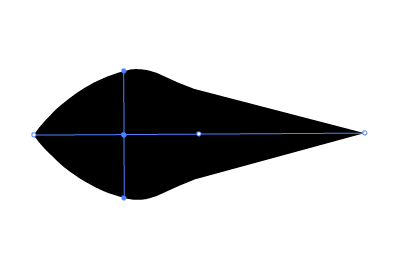
Moving or copying variable breadth applied to a stroke
You can go under or copy Width Points created for a stroke, which in effect, moves operating theater copies variable width applied to stroke. To move a width item, do the following:
- Select the Width tool around
 from the tools panel.
from the tools panel. - Mouseover the stroke to display existing width points, and select the Width Show you want to motility.
- Drag the Width Point along the stroke.
![]() Drive of the Width Point is constrained by the next serial Width Point along either sides.
Drive of the Width Point is constrained by the next serial Width Point along either sides.
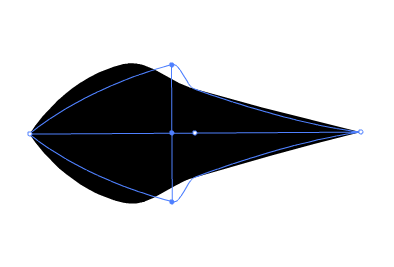
- Breadth bespeak is affected to its new location, and thereby likewise modifying the throw accordingly.
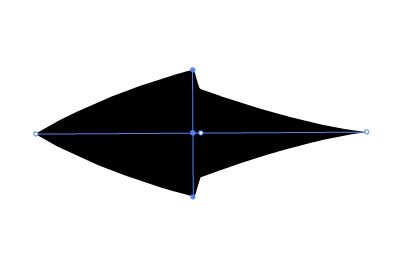
To copy a Width Point, do the following:
- Select the Width tool
 from the tools panel.
from the tools panel. - Mouseover the apoplexy to display existing Width Points, and select the point you wish to written matter.
- Hold Alt ( Pickfor Mack) and drag the breadth point along the stroke to copy the selected Width point.
![]() Movement of the compass point is constrained by the next successive Width Point on either sides.
Movement of the compass point is constrained by the next successive Width Point on either sides.
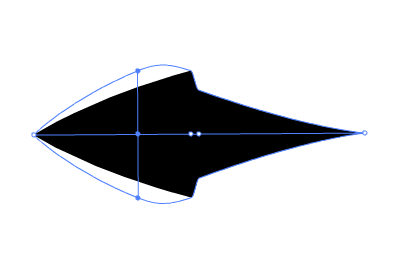
- Width point is derived. This also modifies the stroke consequently.
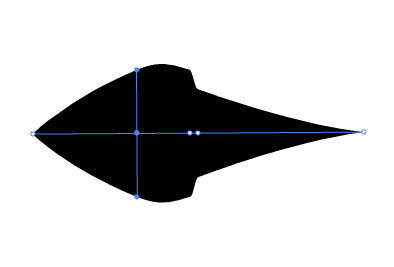
Modifying variable width of a stroke
Modifying the changeable breadth of a diagonal at whatsoever Width point, expands or contracts the solidus proportionately on either sides of the Width Point. However, if you want to change the width on any one side of the point, do the following:
- Select the Breadth tool
 from the tools board.
from the tools board. - Mouseover the stroke to display active Breadth Points, and choose the Breadth Point from either ends of the Width Handle that you want to alter.
- Hold Alt ( Choice for Mackintosh) and drag the Width Handle outward to change the selected Width Point.

- The Width point is moved, and the stroking is modified accordingly.
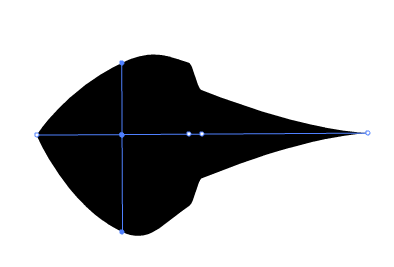
Deleting variable width of a fondle
To erase a Width show, do the following:
- Sneak over and select the Width orient you want to blue-pencil.
- Exhort Backspacer or Erase to delete the Width point.

Width tool controls
The pursual table lists the keyboard modifiers to use piece employed with the Width tool:
| Width mastery tasks | Keyboard modifiers |
| Create non-uniform widths | Alt+drag (Windows) or Opt+embroil (Macintosh OS) |
| Create a simulate of the breadth point | Alt+drag the width distributor point (Windows) or Choose+drag the width maneuver (Mac OS) |
| Copy and go all the points along the path | Alt+Shift+drag (Windows) or Opt+Shift+drag (Mac OS) |
| Select multiple width points and drag them | Shift+click+drag |
| Delete selected width points | Delete |
Saving breadth profiles
After defining the solidus breadth, you can save the variable width visibility from the Properties Inspector.
- Prize the stroke to which you added covariant width.
- Click the + button to the right of Breadth set down-down on Properties Inspector.
- On the Varied Width Visibility dialog, enter a Profile Describ .
- Click Sooner State .

Breadth profiles can then be practical to selected paths by choosing them from the Width Profile drop-down list in the Properties Panel. When a stroke with no variable width is selected, the heel displays the Homogenous alternative. To repair the default option width visibility set, click the Reset Profiles button.
Save up width profile is enabled only variable width apart from default option width profiles is hand-picked on the stage. You can create your own stroke profiles victimisation width tool and redeem them. Likewise, delete width profile icon is enabled when custom width profile is selected in the miss down. Just in case you want to delete any custom profile, you can use this option.
![]() Restoring the default width profile kick in the PI, removes any custom saved profiles. You also synchronize the customs saved profiles to the cloud.
Restoring the default width profile kick in the PI, removes any custom saved profiles. You also synchronize the customs saved profiles to the cloud.
Resilient Color Preview
Live Coloration Preview feature displays the stroke and fill colors simultaneous when drawing a SHAPE on the stage. Information technology allows you to trailer the near-final appearance of a shape when drawing. This have is enabled for all drawing tools available inside Animate.
The Live Color Preview feature is also enabled for Color Swatches within Animate. This allows you to prevue changes of stroke or fill colors for a selected shape on the Arrange. Aside hovering the pointer o'er a desired color, you can meet the tinge change.
Live Color Preview is enabled for color swatches in the favorable panels:
- Tools empanel
- Properties Inspector (PI)
- Stage PI
- School tex PI
- Grid
- Guides
How to Draw Character With Line Tool
Source: https://helpx.adobe.com/animate/using/draw-simple-lines-shapes.html

0 Response to "How to Draw Character With Line Tool"
Post a Comment